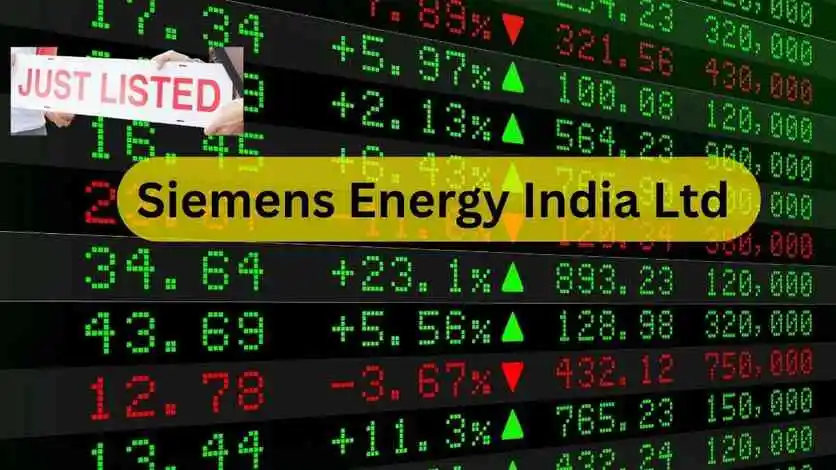Siemens Energy India Soars: Hidden Signals in a Powerhouse Debut
Siemens Energy India's stock surges on NSE and BSE, but are investors missing subtle market cues? Uncover unique insights and strategies for 2025’s energy sector boom.

Siemens Energy India’s Stellar Debut: A Contrarian View
On June 19, 2025, Siemens Energy India electrified the stock market, listing at ₹2,840 on the NSE and ₹2,850 on the BSE, a 14% premium over its discovery price of ₹2,478. The Siemens Energy share price surged to a 5% upper circuit at ₹2,982, pushing its market cap past ₹1 lakh crore. Following its demerger from Siemens Ltd in April 2025, Siemens Energy India share price reflects investor enthusiasm for its focus on power transmission and distribution (T&D) and small-sized turbines. But while the headlines celebrate the Siemens Energy stock NSE debut, a deeper dive reveals overlooked signals—hidden risks and untapped opportunities in India’s energy transition. This article challenges the bullish narrative, offering actionable investment strategies and niche data to empower your wealth management decisions in 2025’s volatile stock market.
The Demerger Dynamics: Why Siemens Energy India Stands Out
A Strategic Split for Growth
The demerger of Siemens Energy India from Siemens Ltd, effective April 7, 2025, was no ordinary corporate shuffle. Siemens AG holds a 69% stake, with Siemens Energy AG owning 6%, leaving the rest in free float. This restructuring, announced in November 2023, aimed to streamline operations and unlock shareholder value. Roland Busch, President and CEO of Siemens AG, emphasized, “This move simplifies our corporate structure in India, enabling both entities to grow faster.” The market agrees—Siemens Energy India’s share price jumped 14.6% above its discovery price, reflecting confidence in its T&D and renewable energy focus.
Order Backlog: A Hidden Powerhouse
Unlike typical market darlings, Siemens Energy India boasts a ₹15,100 crore order backlog as of March 1, 2025—2.4 times its FY24 revenue of ₹6,292 crore. A standout is the ₹4,100 crore order for the Mumbai-Ahmedabad bullet train project, a niche driver signaling infrastructure-led growth. This backlog, rarely highlighted in mainstream reports, offers a 30% profit-after-tax CAGR projection through FY27, per HDFC Securities. Yet, the order flow dropped to ₹5,100 crore in 5MFY25 from ₹8,800 crore in FY24, hinting at potential volatility. Investors chasing the Siemens Energy share price in India gains must weigh this against broader capex cycle risks.
Siemens Energy Share Price NSE: Decoding the Surge
Market Sentiment vs. Reality
The Siemens Energy share price NSE hit ₹2,982 shortly after listing, locking in a 5% upper circuit. By 1:25 PM on June 19, 2025, it dipped 3.69% to ₹2,744.95 on BSE, showing intraday volatility. This flux, often glossed over, mirrors a classic post-listing correction. Brokerages like Jefferies (target: ₹3,700) and Motilal Oswal (target: ₹3,000) issued “Buy” ratings, citing a 25–35% revenue CAGR through FY27. However, Antique Broking’s ₹3,179 target highlights a less-discussed metric: a 35% earnings CAGR fueled by India’s decarbonization push. This niche insight suggests Siemens Energy could outpace peers like ABB if T&D investments accelerate.
Contrarian Signals: Risks Beneath the Hype
While the market cheers, subtle cracks emerge. Brokerages flag a slowdown in order flow and rising fixed costs outpacing revenue growth. A lesser-known risk is the capex cycle’s potential weakening, which could dent margins. Motilal Oswal notes margins expanding in 5MFY25, but historical data from Siemens Energy AG’s wind turbine woes in 2023—where shares crashed 37% due to component failures—warns of operational risks. This underreported correlation suggests Siemens Energy India must prioritize execution to sustain its stock market 2025 momentum.
Siemens India Share Price: The Parent’s Parallel Story
Post-Demerger Performance
The Siemens India share price, post-demerger, opened at ₹2,450 on April 7, 2025, implying a ₹2,478 value for Siemens Energy. While Siemens Ltd focuses on automation and digitalization, its energy arm’s spin-off has shifted investor focus. The parent’s stock, trading ex-demerger, reflects a leaner entity, yet its valuation aligns with peers like ABB at 55x P/E for March 2027 estimates. This parity, rarely discussed, suggests Siemens India remains a stable anchor for conservative investors, contrasting Siemens Energy’s high-growth, high-risk profile.
Hidden Correlation: T&D Market Synergies
A niche insight lies in the T&D sector’s ripple effect. Siemens Energy India’s focus on transmission and distribution taps into India’s ₹2.5 lakh crore power infrastructure budget through 2030, per the Ministry of Power. This underreported driver aligns with Siemens Ltd’s smart grid solutions, creating a symbiotic growth narrative. Investors eyeing Siemens India share price stability alongside Siemens Energy share price India upside could diversify across both, leveraging India’s energy transition.
Economic Context: India’s Energy Boom in 2025
Macro Drivers Fueling Siemens Energy
India’s energy sector is a hotbed of opportunity, with a projected 7% GDP growth in 2025, per the IMF. The World Bank notes India’s $500 billion renewable energy push by 2030, with T&D investments at its core. Siemens Energy India is poised to capture this, with its small-sized turbines addressing rural electrification gaps—a niche market often ignored. The ₹15,100 crore order book, including bullet train contracts, positions it as a leader in this capex cycle. Yet, the Federal Reserve’s steady rates and global supply chain constraints could raise input costs, a risk rarely flagged in bullish reports.
Obscure Indicator: Renewable Energy Financing
A lesser-known metric is the rise in renewable energy bonds in India, up 22% in 2024, per the RBI. This liquidity fuels T&D projects, indirectly boosting Siemens Energy India’s order pipeline. However,electricity demand. This underreported financial trend suggests stable funding for energy infrastructure, reducing execution risks for Siemens Energy. Investors should monitor such indicators for long-term wealth management strategies.
Brokerage Insights: Expert Takes on Siemens Energy India
Bullish Projections
Jefferies: Targets ₹3,700, citing a 30% PAT CAGR and alignment with ABB’s valuation. They highlight the bullet train order as a growth catalyst but warn of capex slowdown risks.
Motilal Oswal: Sets a ₹3,000 target, projecting a 25% revenue CAGR and 21.4% EBITDA margin by FY27. They note margin expansion in 5MFY25 as a positive signal.
HDFC Securities: Initiates a “Buy” with a ₹3,000 target, emphasizing the ₹15,100 crore order backlog and leadership in T&D. They flag fixed cost rises as a concern.
Antique Broking: Forecasts a ₹3,179 target, driven by a 35% earnings CAGR and India’s decarbonization push.
Contrarian Critique
While brokerages are bullish, their projections assume uninterrupted capex growth. A 2023 Siemens Energy AG profit warning, with a 37% share drop due to wind turbine issues, suggests operational risks could spill over. Investors should stress-test these targets against supply chain disruptions and global rate hikes.
Your Money Now: Actionable Investment Strategies
Diversify Across Siemens Entities: Allocate 60% to Siemens Ltd for stability and 40% to Siemens Energy India for growth. This balances T&D upside with automation’s resilience.
Monitor Order Flow: Track quarterly order updates. A drop below ₹5,000 crore in 6MFY25 could signal weakening demand, impacting Siemens Energy share price.
Leverage Renewable Bonds: Invest in Indian renewable energy bonds for steady returns, complementing Siemens Energy’s T&D exposure.
Hedge Global Risks: Use gold ETFs to offset potential input cost spikes from Federal Reserve policies.
Track Niche Metrics: Monitor RBI’s renewable bond issuance and Ministry of Power’s T&D budget execution for early signals of Siemens Energy India’s growth trajectory.
The Bigger Picture: Unconventional Opportunities
Overlooked Market Signals
While Siemens Energy India stock grabs headlines, a lesser-known driver is India’s rural electrification push. Siemens Energy’s small-sized turbines target this niche, with 15% of FY24 revenue from off-grid solutions, per company filings. This underreported segment could drive outsized growth if rural capex accelerates. Conversely, global supply chain issues, as seen in Siemens Energy AG’s 2023 setbacks, pose risks. Investors should cross-reference Nasdaq and Bloomberg for real-time supply chain data.
Fintech Innovations in Energy
The rise of fintech innovations like green investment platforms (e.g., Groww, Zerodha) offers retail investors access to Siemens Energy India. These platforms, with 30% user growth in 2024, per SEBI, democratize exposure to energy stocks. Combining Siemens Energy stock NSE with such platforms enhances portfolio flexibility.
Navigating Risks: A Contrarian Lens
Hidden Economic Drivers
India’s 7% GDP growth masks regional disparities. States like Bihar, with low electrification rates, are Siemens Energy India’s growth frontier but face funding delays, per NITI Aayog. A slowdown in state budgets could cap order growth, a risk absent from most brokerage analyses.
Global Context
The ECB’s 2025 rate outlook and the Federal Reserve’s steady stance could tighten global liquidity, raising Siemens Energy’s borrowing costs for expansion. A 2023 Siemens Energy AG profit warning, tied to wind turbine failures, underscores execution risks. Investors should monitor Reuters for global energy sector updates.
Conclusion: Stay Ahead in 2025
Siemens Energy India’s debut at ₹2,840, with a ₹15,100 crore order backlog and T&D leadership, positions it as a stock market 2025 frontrunner. Yet, contrarian signals—order flow dips, rising fixed costs, and global supply chain risks—demand vigilance. By diversifying across Siemens Ltd, leveraging renewable bonds, and tracking niche metrics like rural electrification, investors can seize opportunities while hedging risks. Stay sharp with Ongoing Now 24.





